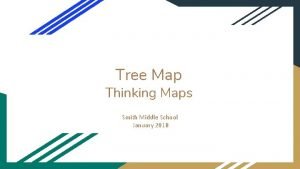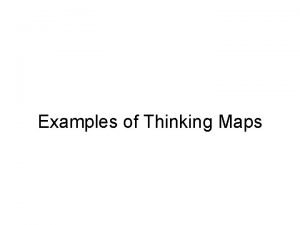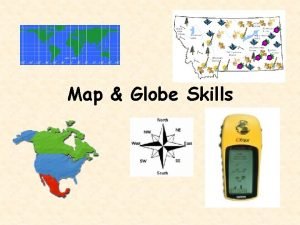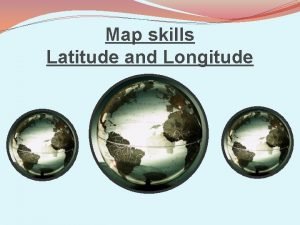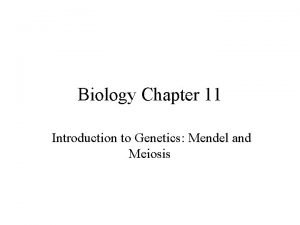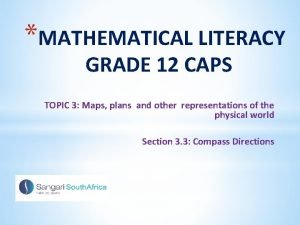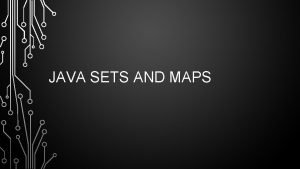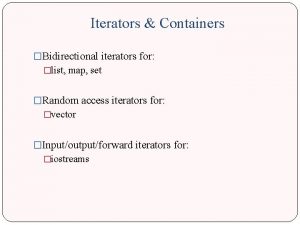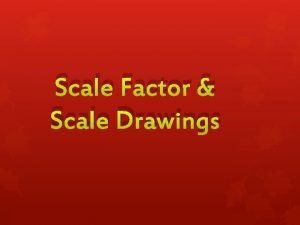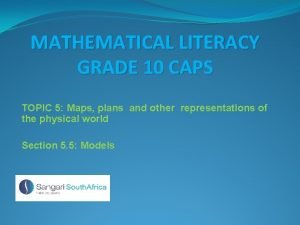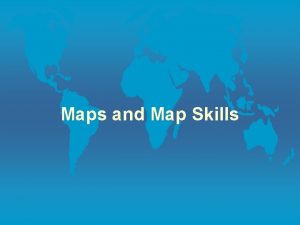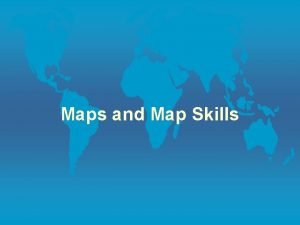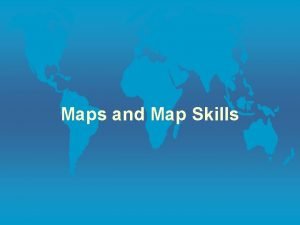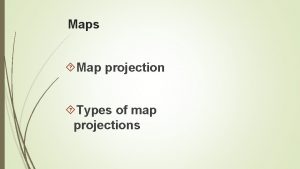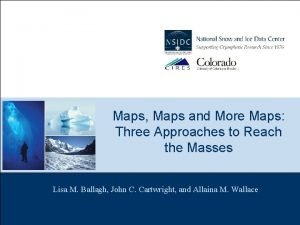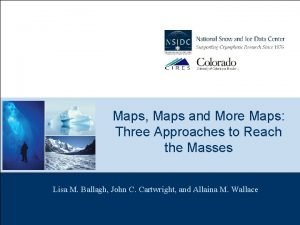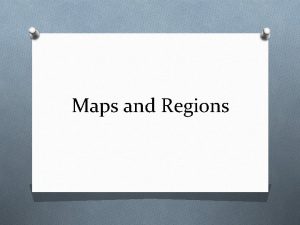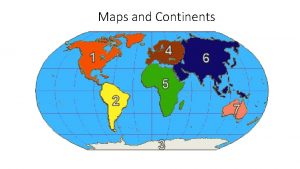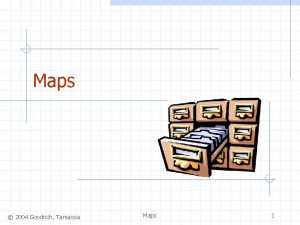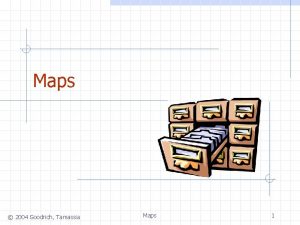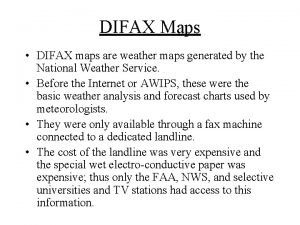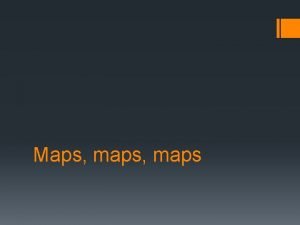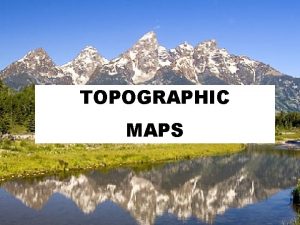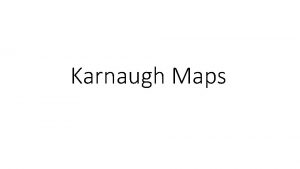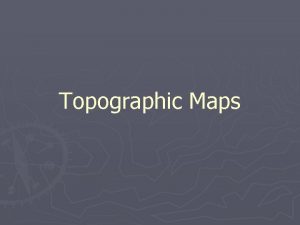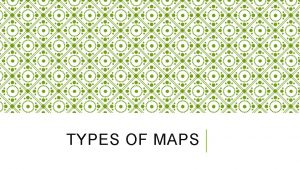Maps and Map Skills What is a map


















- Slides: 18

Maps and Map Skills

What is a map? A flat, 2 dimensional representation of earth or a selected place, can show selected elements or features of a place

Map Projections �A map projection in a systematic transformation of latitudes and longitudes of locations of a 3 -D world onto a flat surface. �Common projections for earth: �Mercator �Robinson �Goode’s Homolosine Equal-Area �There is no limit to the number of map projections possible. �No projection is 100% accurate, each will have some level of distortion (changes in the shape of an object)

A globe is the BEST representation of Earth, due to it’s spherical nature. But, is impractical to use and does not include as much detail as a map can.

Parts of a Map �Every good map will include these essential elements: �title �scale �compass rose �legend/key

Title �Should be the first thing you look at �Will frame your mind set for what you are about to look at �Will state obvious information as to what the map is depicting �Example: “Mexico before Independence” “China: Natural Resources” “Mid-Atlantic Triangle Trade” “The Spread of Islam”

Scale �Shows the relationship between distance on a map and distance on the ground �Will give you an idea of how much ground the map covers �Maps with larger scales will cover more ground than those with smaller ones �Ex. 1 in = 1 mile very small scale �Ex. 1 in. = 100, 000 miles very large scale

Compass Rose �Symbol on a map that indicates cardinal directions �North, South, East, West �Can sometimes include intermediate directions �NW, NE, SW, SE �Can also be as simple as an arrow pointing North, all others are supposed to be assumed based on that �DO NOT assume that a map is

Legend or Key �Explanation of symbols and abbreviations used on a map �Most maps are not big enough to include labels for everything, so a legend/key comes in very handy �Will help make sense of the map �Second thing that should be looked at

Types of Maps There are 7 major types of maps: �Physical �Political �Topographic �Climate �Resource/Economic �Street/Road �Thematic

Physical Map Shows the major physical features of an area, focuses on the natural environment �Rivers �Mountains �Vegetation �Bodies of water

Political Map Shows the boundaries of states, countries, or other governmental divisions. �Will usually show capitals and major cities

Topographic Map Shows natural and man-made features of the land, marked by contour lines showing elevation and shape of the land

Climate map Gives information about the climate and precipitation of a region

Resource/Economic Map Show the major natural resources and agricultural and industrial products of an area. �Will use color coding and many symbols

Street/Road Map Shows smaller areas such as cities and towns, used to find directions �Will highlight major roadways, street names, and important landmarks.

Thematic Map Shows information relating to a specific theme. Ex: �Spread of religion �Trade routes �Population density �Are often combined with one of the other types of maps for added detail �Possibilities are endless!

When you first encounter a map… 1. Read the TITLE! This will tell you what you 2. 3. 4. 5. are about to look at. Study the legend/key. It will tell you more details about what you will be looking at. Identify what the colors and/or symbols mean. Find the scale. Are you looking at a large or small area? Look at the compass rose. Identify which way is north. Finally, look at the map. Identify the colors and symbols from the legend/key. Study the
 Google reittihaku
Google reittihaku Examples of intrapersonal skills
Examples of intrapersonal skills What sre soft skills
What sre soft skills Skills passport
Skills passport Tree map thinking process
Tree map thinking process Examples of thinking maps
Examples of thinking maps Map and globe skills
Map and globe skills Absolute location
Absolute location Mathematical literacy grade 12 maps and scales
Mathematical literacy grade 12 maps and scales Maps and scales maths lit grade 12
Maps and scales maths lit grade 12 Section 11-4 meiosis answer key
Section 11-4 meiosis answer key Section 11-5 linkage and gene maps
Section 11-5 linkage and gene maps Poor maps and navigational tools
Poor maps and navigational tools Section 11-5 linkage and gene maps answer key
Section 11-5 linkage and gene maps answer key Types of maps in maths lit grade 12
Types of maps in maths lit grade 12 Maps
Maps Maps and sets support bidirectional iterators.
Maps and sets support bidirectional iterators. Maps and scale drawings worksheet
Maps and scale drawings worksheet Maps plans and other representations of the physical world
Maps plans and other representations of the physical world




